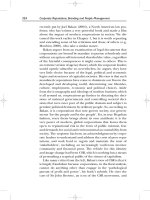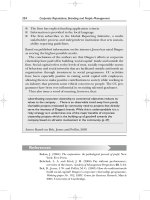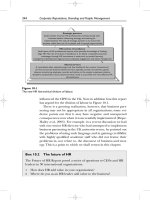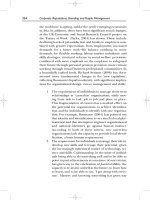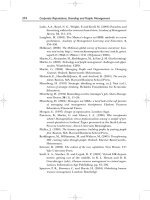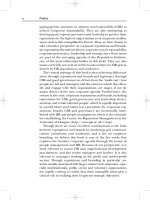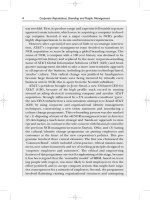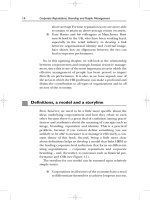Tài liệu Corporate Reputations, Branding and People Management 14 ppt
Bạn đang xem bản rút gọn của tài liệu. Xem và tải ngay bản đầy đủ của tài liệu tại đây (140.4 KB, 10 trang )
This page intentionally left blank
CHAPTER
The quality of
individual employment
relationships and
individual employee
behaviour
4
Introduction
In the previous chapter, we focused on how organizational
identity and actions shape image. We also indicated, in turn,
how the identification process can influence the individual
identities (or self-concepts) of employees. Using two examples,
we illustrated how this apparently academic distinction between
organizational and individual identities has important practi-
cal consequences, since the latter is rooted in how employees
perceive themselves, and not how they see their organizations.
That said, there are processes at work in which individuals may,
under certain circumstances, come to incorporate elements of their
organization’s identity into their self-perceptions, drawing on
what academics describe as social identity and self-categoriza-
tion theories (Hatch and Schultz, 2004). So, the core message
for practitioners is that changing employees’ identities – their
self-concepts of who they are – is a more difficult and uncertain
task than many of the more basic culture management and
communications-driven, customer relationship texts would
have you believe, leaving aside the ethical issues associated with
‘brandwashing’. We will deal with this issue when we discuss
the effectiveness of employee branding in Chapter 8, which
is an attempt to use communications techniques to achieve
greater levels of identification with existing employees, as well
as recruiting new ones in the so-called ‘war for talent’ (Barrow
and Mosley, 2005). Just how effective employer branding and
HR communications can be is open to question, and will
depend on their understanding of this identification process,
psychological contracts and other key individual–organizational
linkages.
Acknowledging these notes of caution and ethics for the
moment, to which we shall return, there is little doubt that how
individual employees see themselves, how they behave and the
kinds of connections they have with their organizations will
shape organizational identity and actions. To repeat our core
message, this is one of the main premises of this book, that rep-
utations and brands are driven from the inside. We refer to this
interest in employee perceptions and behaviours as the quality
of individual employment relationships; we use it to encompass
a set of distinctive, but overlapping, processes at work, all of
which are slightly different in conception and effects but, in
combination, link employees to their organizations. These
processes are psychological contracting, and the main individual
organizational linkages of identification, internalization, psycho-
logical ownership and commitment (e.g. Pierce, 2001, and Sparrow
and Cooper, 2003, among others). Such a list is often con-
fusing for practitioners, and that is probably why the idea
of engagement has become so popular in recent years, since it
116 Corporate Reputations, Branding and People Management
Chapter 4 The quality of individual employment relationships 117
promises to tap into or overlay all of the others as a form of
temperature check for HR managers (see Figure 4.1). However,
like any idea or piece of equipment (in this case, survey tools)
that claims to do everything (especially on the cheap), it may
result in doing nothing particularly well. And, as we will argue,
there is more than a hint of this problem in the consultancy-
based reworking of engagement. So, we take a more detailed
look at these ideas in this chapter to reveal their similarities
and differences and to provide you with a necessarily more
complex picture of an undoubtedly complicated problem: how
do people come to relate to their organizations and how can
we help them realize their aspirations through work? (We use
‘necessarily’ because ‘complexification’, rather than simplifica-
tion, often serves everyone’s interests, including those busy
managers who look for simple answers. This is based on the
premises that the social world isn’t a simple place and one-size-
fits-all solutions rarely work without some grounding in con-
text). To do this we will make use of two ideas that are popular
in the human resource management literature. The first, the
psychological contract, is supported by research for the Chartered
Institute of Personnel and Development (CIPD, 2003a, 2004).
The other is engagement, a bit of a catch-all term for more
complicated individual–organizational linkages, including iden-
tification, internalization, commitment and psychological own-
ership, though, as we shall see later, it does bring something
extra to the party.
Finally, it almost goes without saying, how individuals behave
at work is one of the major influences on reputations and brands.
Such workplace behaviour depends on the outcomes of knowl-
edge, skills and abilities – the human capital pool which, in
turn, relies on organizational investment in knowledge stocks
and knowledge flows. This is one of the key messages of the
RBV and strategic human resource management (SHRM)
(Wright et al., 2001), which we shall also touch on in this chap-
ter and take up in Chapters 5 and 6. Let’s begin by examining
a case we researched with close colleagues to show how our
organizing framework for this chapter (Figure 4.1) might be
applied.
118 Corporate Reputations, Branding and People Management
What do
employees
feel they are
entitled to expect
from their
employees
(E)?
Who am I
(identity)?
What do I
believe
(internalization)?
Is it mine?
(ownership)
Will I stay
(commitment)?
Do they
perceive
these valued
expectations
(D)?
Which
expectations
do employees
most value (Ve)?
The
employment
relationship
Psychological
contracts and
trust
Engagement behaviours
E ؋ V
e
Gap ؍ (E ؋ V
e
) ؊ D
Figure 4.1
A framework for understanding the employment relationship.
Box 4.1 ‘Psychological contracts’ among oil workers in
the UK offshore drilling industry
The offshore drilling industry
In 1999 the industry comprised 14 companies employing some 6000 men
and a limited number of women in onshore and offshore operations. The
work of the offshore drilling employees is usually depicted as hazardous,
involving long hours in shifts and working away from home. The majority
of employees on the drilling rigs are semi-skilled roustabouts, supervisors
and drilling technicians and technologists, most of whom have worked in
the industry for a number of years. Despite the contracting nature of
employment conditions, some employers and many employees tend to
